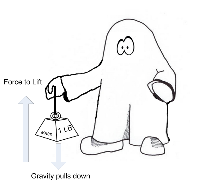© 2017, Kyle T. Cobb, Jr. All Rights Reserved. Links | Terms and Conditions







EXPLORE THE SCIENCE BEHIND THE PARANORMAL
GHOSTS AND DEMONS: THE LOST THINGS EXPLORES THE SCIENCE FUNDAMENTALS IN AN EASY TO UNDERSTAND, NON-


A LOOK INSIDE
The Science chapter of GHOSTS AND DEMONS: THE LOST THINGS explores the physics behind how sound works. Armed with this knowledge, the reader will explore theories behind Electronic Voice recording. Discussions on Electromagnetic forces and the physics of light allows for discussion on the use of EMF detectors as well as infra-
AN EXCERPT FROM THE SECTION ON EVPS
One of the cornerstones of modern paranormal investigation is the use of Electronic Voice Phenomena (EVP) which is also known as Instrumental TransCommunication. Even though the use of EVPs is the primary tool of investigators, most researchers have absolutely no real understanding of the science behind the tools they are using. Beyond not understanding the physics, the knowledge gap continues in to a basic failure to understand the electronic devices and how they actually work.
Television versions of EVP sessions
So thanks to the dozens of televisions shows feature ghost hunting, the general public has a rough idea of how EVP sessions work.
When discussing the television EVPs, there are few key things that should be mentioned in a less than delicate manner.
First, most TV show EVPs are faked. Whether it is by clever manipulation of the existing audio tracks, failure to account for outside audio (including the sounds of the supporting crew), incompetence or straight out forgery, EVPs can not be routinely located on an assembly line basis as many TV shows suggest. It is important to remember, these shows are there to entertain. Much like a fishing show, the only action is in actually pulling in the fish. While some groundbreaking shows featuring everyday people turned paranormal investigators survived in the early days with proving places “not haunted,” the public demand for entertainment requires spot music, blurred photos and eventually haunted evidence.
Secondly, television shows are based around “ghost hunts” and not paranormal investigations. Simply put, a true investigation is just that. Every detail is document, measured and cataloged. Independent historical research is conducted on the location. Teams will work the clients over and over again to understand the nature of the haunting. In contrast, a “hunt” is like a deer hunter going into the woods to find a deer. It is an isolated event. Sure, they are going to do everything they can to take advantage of that session, but once it is over (aside from dressing the results), the hunt is finished.
Every television show dealing with EVPs makes the review of audio seem to be a relatively quick process. The reality is that the amount of time is far more substantial. Every recorder’s audio track must be carefully reviewed in a real time, 1 to 1 ratio. So for every hour of the investigation, one hour is required to listen to each hour on the audio recorder. So if you have 10 audio recorders at a site and do an 8-
–––––––––––
AN EXCERPT FROM THE SECTION ON EMFS
One of the theories concerning apparitions is the belief that they emit an Electromagnetic force (EMF) that is a detectable energy pattern outside of normal background energy.
Electromagnetic radiation is a term used to describe forms of energy that are emitted and absorbed by charged particles. All of the forms of Electromagnetic radiation travel in waves through space (but some EM forces like light also have properties that seem to behave like particles). All electromagnetic waves travel with the same velocity in a vacuum—“C” also known as the speed of light, which is 299,792,458 meters per second or about 186,282 miles per second. The Electromagnetic radiation waves also carry with them a magnetic field component that are orthogonal to each other and also to the propagation of the waves.
Electromagnetic radiations can be grouped as having several types of waves in different wavelength and frequency regions. The Electromagnetic spectrum is used to help describe these radiation types based on different frequencies and wavelength as they vary based on their wave characteristics, uses and applications.
As we will discuss later in this book, most of the range of the Electromagnetic spectrum is outside the human ability to see directly with our eyes. In today’s modern society, Electromagnetic waves are a fundamental component in daily life.
What is an Electro-
Electric fields are created by differences in voltage and magnetic fields are created when electric current flows. The higher the voltage, the stronger the resultant field and the greater the current, the stronger the magnetic field. While an electric field will persist at the same level even if there is no current flowing, a magnetic field will vary based on the power consumption. Electromagnetic waves are carried by particles called quanta. Quanta with a higher frequency, and therefore a shorter wavelength, carry more energy than lower frequency fields.
While electromagnetic fields exist in nature in the form of things like lightning and the earth’s magnet field, non-
Certain electromagnetic waves carry enough energy per quantum that they break bonds between molecules. For example, some highly energetic waves in the electromagnetic spectrum such as gamma rays given off by radioactive materials, cosmic rays and X-
–––––––––––
EXCERPT FROM HOW LIGHT WORKS
As human beings we are creatures primarily designed to operate in daylight under the bright rays of a yellow sun. As a result, we have evolved as creatures that function less than optimally in low light conditions. Inherently, our literature and popular culture treat darkness as a mysterious and sometimes dangerous place.
As a paranormal investigator, it is important to understand the human and paranormal relationship with light.
When discussing paranormal event, there are always questions like:
How can a paranormal entity be invisible?
Why are ghost hunts at night on TV?
Why do some paranormal investigators use infrared or ultraviolet video equipment?
Why do digital cameras seem to capture more paranormal events than other forms of camera?
In this section, many of these questions will be addressed.
But first, it is important to understand some of the science behind light.
How does light work?
In understanding how light works, the first concept to understand is that light behaves as a ray, as a wave and as particles.
As a ray
When light acts as a ray, it exhibits three key properties of light: reflection, refraction and scattering. When a light ray strikes a smooth surface, it bounces off. When the ray is reflected from the surface, it is at an angle equal to the angle at which the incoming ray hit the surface. This is called the law of reflection. In more scientific terms, the law is stated as "the angle of incidence equals the angle of reflection."
When the light rays strikes a rough surface, the rays are scattered as they reflect on a variety of uneven surfaces. It is scattering property which allows printed materials and patterns to be viewable from multiple angles.
As light passes from one medium to a second, it may be bent by slowing light’s speed down. This phenomenon is referred to as refraction. The angle of refraction depends on how much the material slows down the light. One common object that takes advantage refraction is a lens. Essentially, a lens is a transparent material with curved sides that cause light to be concentrated or dispersed. When light enters the lens, it is refracted. As it exits the lens, it is again refracted. The net effect of the two refractions is that the light has changed directions.
As a wave
In 1801, Thomas Young, an English physician and physicist, proved that light has additional properties beyond a ray. Young’s experiment used a card with two holes cut side-
–––––––––––




Physics of sound
Physics of Energy
Physics of Light
Newton’s Laws